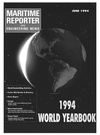
Page 124: of Maritime Reporter Magazine (June 1994)
Read this page in Pdf, Flash or Html5 edition of June 1994 Maritime Reporter Magazine
INLAND \yi:sti:i?n aiachiki: wokics 1870 HARBOUR ROAD, NORTH VANCOUVER, B.C. V7H 1A1 CANADA
TELEPHONE: (604) 929-7901 FAX: (604) 929-7951 OR 929-5329
Circle 336 on Reader Service Card 134
Circle 261 on Reader Service Card
Maritime Reporter/Engineering News
Inland Issues
Safety Of Towing Vessels, Environment; And
Efficient Intermodal Shipping Top Agendas by
Dan Maniotis, assistant editor
The issues confronting the in- land waterways/Great Lakes com- munity largely deal with safety on the waterways—whether it be navi- gational safety issues or the safety of the environment. But efficiency is also a paramount issue, especially since an era of increased trade with neighboring countries may be her- alded by the passage of NAFTA.
Inland Waterway
Infrastructure Corps of
Engineers Projects
A hearing of the House Public
Works Subcommittee on Oversight and Investigations on May 4 ex- plored the issues of inland water- way infrastructure, port develop- ment, and related issues. Inland
Waterways User Board (IWUB)
Chairman Berdon Lawrence re- portedly urged the U.S. Army Corps of Engineers to devise innovative and inexpensive construction tech- niques for pending projects, saying that without such innovation, only one project would be authorized in the next decade. "Maritime System of the
Americas"
At a recent SNAME Symposium at the Merchant Marine Academy in Kings Point, N.Y., Deputy Mari- time Administrator for Inland Wa- terways and Great Lakes John
Graykowski spoke of a MarAd study of a "Maritime System of the
Americas" that attempts to identify more efficient means of transport- ing goods between the U.S. and
Mexico, the U.S.'s third largest trad- ing partner, as well as Canada, Cen- tral America, the Caribbean, and the northern rim of South America.
The per se Maritime System of the
Americas refers to the Great Lakes, the Mississippi and its navigable tributaries, the Tennessee
Tombigbee Waterway and its tribu- taries, the Gulf Intracoastal Water- way, the Gulf of Mexico and the
Caribbean Sea.
Mr. Graykowski noted that 60 percent of U.S. agricultural goods come from the "heartland" of the
U.S., so it has become increasingly important to find efficient methods of transporting heartland goods to these areas.
The Maritime System of the
Americas study began in 1992, ac- cording to Project Manager Doris
Bautch of the Maritime Adminis- tration, predating the passage of
NAFTA. However: "Now that
NAFTA has passed," she said, "we expect that there will be more trade moving by water," noting that she has received a lot more inquiries about the study since NAFTA.
The study has three phases, one of which is complete: it studied small vessels on the waterways and rivers that link the central U.S. to various neighboring countries — with heavy focus on the Mississippi — and dis- covered a niche market for such ships there. The phase one study also found that vessels or vessel systems which are capable of safe navigation both on inland and ocean waters have sufficient economies to serve small volumes of general car- goes, containers, and minor bulk commodities. According to the study, the advantage of such river/
Crowley tug Bulwark towing a module on route to Alaska, as part of the annual sealift. ocean service is that it only has to capture a relatively small portion of a large and rapidly growing market for general cargo movements to
Mexico and South America.
Phases two and three are being conducted concurrently, and Ms.
Bautch said she hoped a final re- port would be completed by the end of the year. Phase two will study short sea shipping, covering vessels in the Gulf of Mexico and the Carib- bean, with transshipment at coastal ports for trade among Canada, the
U.S., Mexico and other neighboring countries. Phase three will examine intermodal connections of deep-draft oceangoing vessels, with consider- ations for alternatives.
A scrapped possible phase four of the study would have examined the possibility of lengthening the Gulf
Intracoastal Waterway to connect the "heartland" of the U.S. with
Mexico. It was decided, said Ms.
Bautch, that the possibility of that extension would not be explored at this time.
COSPOLICH
In Marine Refrigeration, WeVe Got You Covered r
Cospolich designs and manufactures refrigerators for all types of marine applications and offshore installations.
We build lo one standard only-the best. Thai's why all of our refrigerators, freezers, freezer doors, brine tanks, and components meet U.S. Navy standards.
Our "hatchable" modular refrigerators solve replacement problems by eliminating costly cutting through decks, bulkheads, and accessvrays.
Specify Cospolich. Superior design, construction, quality and service since 1937.
REFRIGERATOR CO. 949 Industry Road • Kenner, Louisiana, USA 70062
Tel: (504) 469-6555 • Fax: (504) 469-1819

 123
123

 125
125
